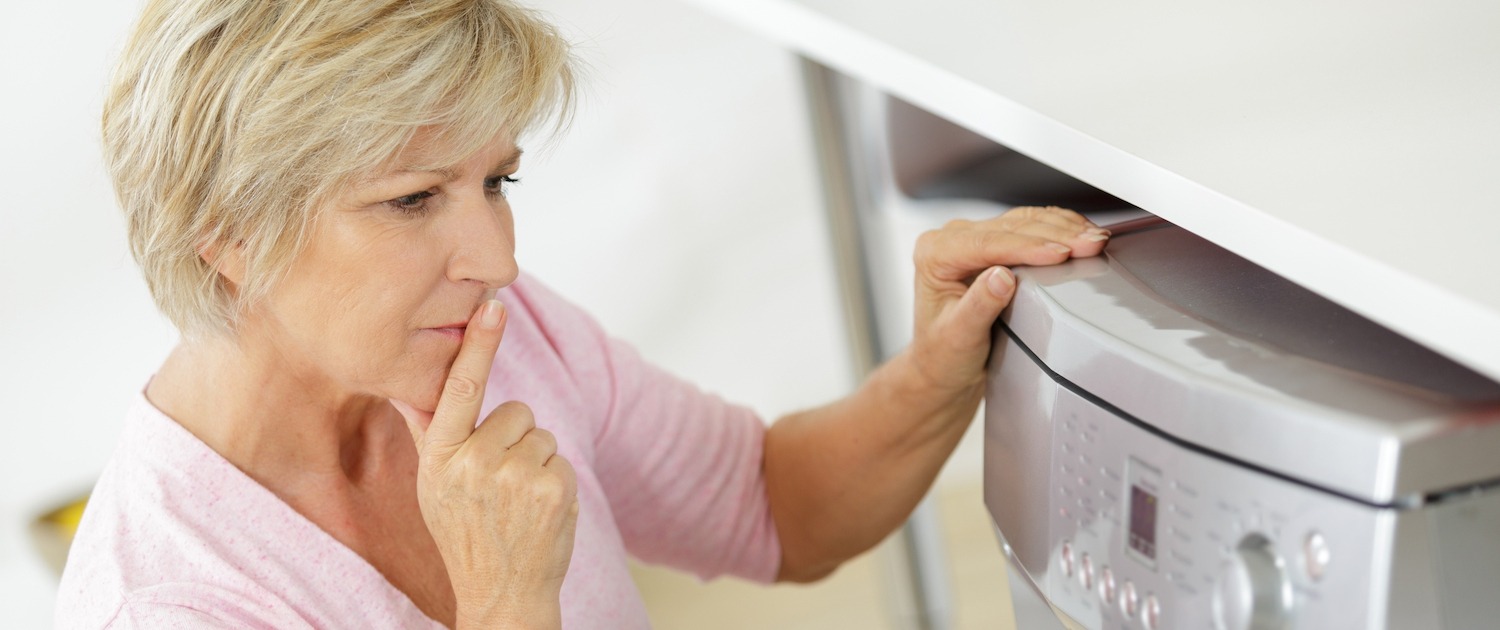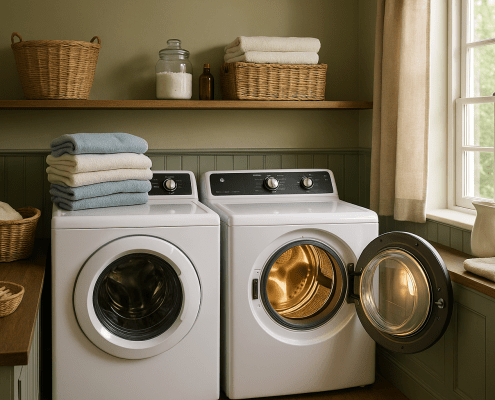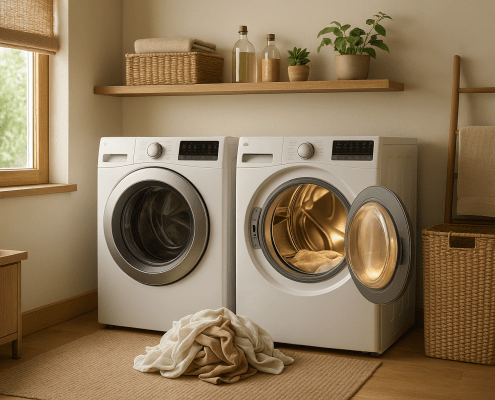Washing Machine Shaking: Top 8 Problems and Fixes for Top-Loading and Side-Loading Washers (With Video!)
APP Expert / Thursday September 16, 2021
Is your washing machine shaking like it’s got a mind of its own? This common yet frustrating problem could be caused by several components, ranging from leveling legs to tub bearings. Below, you’ll find a comprehensive guide that includes a step-by-step how-to video to troubleshoot and fix your washer’s wobbles, all in the comfort of your own home.
If a washing machine is shaking while it is being used, there are eight washing machine part components that could be causing the problem. Before troubleshooting, making repairs, or replacing any parts, it’s crucial to shut off the circuit breaker for the washing machine or unplug it from the wall. The hot and cold water supply should also be turned off for safety reasons before moving forward. Once your washer is safe to work with, continue with this guide to learn to troubleshoot your shaking washer yourself.
When you have identified the part needed for your washing machine, search below using your specific washer model number to identify the exact part needed:
1. Leveling Legs
The leveling legs are the first component to look at if a washing machine is shaking while in use. These legs are created to adjust the washer so it sits level on the ground. There are many different styles of leveling legs, but all of them are designed to do the exact same thing. Most of them screw in and will have a locking nut that holds them in the right place. Some have washers with self-adjusting legs in the back. Rubber feet are found on the bottom to absorb vibrations from the washing machine.
The first step to checking on the legs is to find out if the washer is level. This is done by rocking the washing machine back and forth to ensure that it is. If the washing machine is not level, it will need to be tilted back so the leveling legs can be inspected. Sometimes, the only thing that will be required is a simple adjustment rather than a full replacement.
After the washing machine has been tilted back, check the legs for missing rubber feet or damage. Washers that are front-loading tend to wear the legs out quicker than side-loading models. If any of the legs have sustained damage, they will need to be replaced. Be aware that, in some cases, the leveling feet and legs are sold separately.
If the legs are in good condition, adjust them so the washer will sit level against the floor. With washers that have self-adjusting legs, the machine needs to be tilted forward while inspecting whether the feet drop down. While lowering the washing machine, the legs should adjust their level to meet the floor. If the washing machine is still not level, tilting it back and adjusting the front legs may be required.
2. Shock Absorbers
If your washer still moves and shakes, the next thing to check is the shock absorbers on the washing machine. These are designed to cut down on the tub movement from the washing machine while it is running. Shock absorbers are only found on front-loading washers, and there will be three or four depending on the washer brand. They expand and compress to support the tub while it moves up and down.
The shock absorbers can be found on the bottom of the washer and will be attached to the base and the tub. The first thing you should do is visually inspect the shock absorbers to see if they are leaking oil or broken. If no physical damage is seen, the shock absorber may need to be removed to see if it is still working. Compress the part by hand and it should offer some resistance. Next, pull it out, and as the pressure inside increases, it should become harder to pull.
If the washer shock absorber moves smoothly and the two components separate, the shock absorber is no longer working and needs to be replaced. This will stop the issue of the washer moving and shaking when it’s in use.
3. Suspension Rods & Dampening Straps
The suspension rods and dampening straps are the next parts to look at with a washing machine that moves and shakes. These components are in charge of controlling the movement and vibrations of the tub while it is in use. The suspension rods act in the same way as to shock absorbers, but the tub hangs on them instead of riding on top of them to control the vibrations of the tub during a cycle.
If dampening straps are also in the washing machine, they add extra control to the suspension rods. Both dampening straps and suspension rods are only included on top-loading washing machines. The rods start at the top of the cabinet frame and go down to the bottom of the outer tub, while the dampening straps go from the upper cabinet to the cover of the tub.
Testing the rods can be challenging since it’s hard to determine visually if there is damage unless the upper ball and socket are damaged. Pushing down on the tub is one way to test the rods. When you do this, there should be one smooth bounce. If the tub bangs around instead, the rods are likely no longer working.
Another thing to pay attention to when running the washing machine is whether it has a balanced load but it easily goes out of balance during the spin cycle. This can cause the washer to move and shake. If the dampening straps or suspension rods aren’t working correctly, they need to be replaced.
4. Spider Support Arms
With front-loading washers, the next component to look at is the spider support arms. This part is dedicated to holding the tub in place while the washing machine is running. In most cases, this component has three arms that attach to the inner tub and a shaft that goes to the motor or drive pulley. When the pulley or motor turns, the tub arm spins so the clothes in the washer are agitated.
This part is found between the outer and inner tubs, and if the washer is moving or shaking, it might be an indication that the arm is no longer working correctly. There are several ways to determine whether this is the problem. If the washer is going out of balance during the spin cycle, this is one indication. Spin the tub manually and there may be a clicking or rumbling sound. This can be caused by spider support arm parts that have broken off.
Another thing to check is the gap between the outer and inner tubs while you spin it. The distance between the two should be the same in all areas around the two tubs. If wobbling occurs while turning the tub, this is another indication that one of the arms could be broken. Another thing to check is the bottom of the door seal. If there is damage to the outer tub, this is another sign that the arms may be broken and moving around. If you decide that the spider support arm is broken or damaged, a replacement will be required.
5. Springs
The springs of a washing machine are there to control the movement of the tub. There are many kinds of springs in washers, depending on the model and manufacturer. Regardless of where they are located, they are all designed to do the same thing. Front-loading washing machines will have a large suspension spring on each side to support the tub from the top. Top-loading washers can use many different springs, but they are often hooked into the washer base and attach to the frame of the tub.
Take a look at each of the springs in the washer for damage or rust. If the hook points are damaged, the springs are stretched out, or the springs are broken, the springs will need to be replaced.
6. Suspension Pads
The next component that can cause a washing machine to shake or move is the suspension pads. These come in various styles, but all are designed to do the same thing. Some are large rings at the base of the washing machine, while others are small plastic pads that the frame rides on. The smaller pads are found between pieces of the frame while the larger rings are underneath the assembly. The pads are used to move the suspension smoothly when the washer is on.
The pads or rings may be worn out if your washer is shaking and moving. This can cause the suspension to bind up so they should be inspected for damage. If there is anything wrong with them, the pads should be replaced. It will help stop the washing machine from moving while doing a load of laundry.
7. Balance Ring
The balance ring can also play a part in causing a washing machine to shake. This ring is located on the inner tub and helps control excess vibrations during the spin cycle. Balance rings are filled with liquid that counterbalances the spinning tub. With a top-loading washer, the balance ring is on the top of the inner tub. Front-loading washers do not always have them, but if they do, they tend to have two with one on each end of the tub.
The balance ring may be damaged and dried out if the washing machine is shaking and moving. With a top-loading washer, it’s simple to inspect. Take the tub cover off and check to see if there is any damage to the balance ring. Visual inspection can’t be done with a front-loading washing machine. If other problems have been ruled out, the washer may need to be taken apart to determine if the balance ring is an issue.
Another way to see whether the balance ring is working is by rotating the inner tub and listening for the sound of liquid moving. A balance ring that has dried up will not create this sound. If the balance ring is damaged or no longer contains liquid, it will need to be replaced.
8. Tub Bearings
The final thing to check with a moving or shaking washing machine is the tub bearings. These help the drive shaft rotate when the washing machine is going through its cycles. Most washers will use a sleeve bearing or a ball bearing that the drive shaft will ride on. When a sleeve bearing fails, it will typically result in a squealing sound. If the washer is moving and shaking, it’s usually because it contains ball bearings.
With a front-loading washing machine, the bearings can be found on the back of the inner tub. Top-loading washers will have bearings behind the motor on the bottom of the outer tub. If the tub seal is leaking and water reaches the ball bearings, this can cause them to fail. Ball bearings can also stop working due to wear and tear.
Bearings that are beginning to stop working will create a squeaking noise and the vibrations and noises will increase as the bearings get worse. In most cases, the vibrations will be most noticeable during the spin cycle. Turning the inner tub using your hands is one way to check whether the bearings are working. If they aren’t working, you may hear noises or feel the bearings turning in an rough manner.
Failed tub bearings on a washing machine should be replaced. It’s also recommended that you change the tub seal while doing the replacement.
Where To Find Us
If you need any replacement parts for your appliances, you can enter your model number at AppliancePartsPros.com to locate and order them quickly. Most orders arrive in just two business days, and we have tons of great information in our repair help section and YouTube videos to help you troubleshoot.
Stay connected with the latest DIY tips, tutorial videos, and repair guides by following us on Facebook, Instagram, and Twitter. We love hearing about your repair stories and successes. If you need more help or want personalized guidance, feel free to contact or call us at 877-477-7278. We’re ready to help you take on your next project with confidence!
Since 1999, AppliancePartsPros.com has helped millions of people repair their broken appliances by providing high-quality original parts at well below retail prices, free support and troubleshooting, and award-winning customer service from an expert, friendly, US-based customer support team!
Hi! I’m Matt H., and I’m thrilled to be your guide through the world of appliance repair with over 25 years of invaluable experience in the industry.
From the early days of my career, I have been deeply passionate about appliances and their inner workings. Over the years, I’ve seen it all – from vintage models to the latest cutting-edge technology – and I’ve dedicated myself to mastering the art of repair. With a toolbox in one hand and a wealth of knowledge in the other, I’ve tackled every challenge that has come my way, learning and growing with each repair.
Join me as we dive into the intricacies of appliance repair. From step-by-step repair guides to explanations of common problems and their solutions, I’ll be here to simplify the repair process and empower you with the knowledge you need to keep your appliances running smoothly.
Feel free to explore our blog, ask questions, and leave comments – this platform is a space for learning, sharing, and growing together. Let’s work together to ensure that your appliances continue to serve you for years to come.
Thank you for joining me on this journey, and I look forward to being your go-to resource for all things related to appliance repair!





